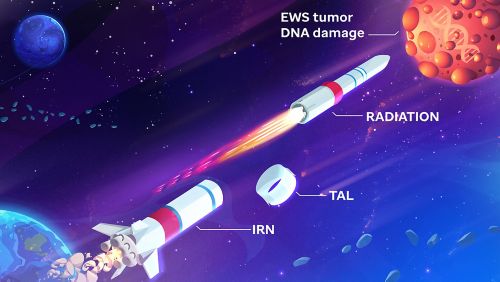St. Jude Family of Websites
Explore our cutting edge research, world-class patient care, career opportunities and more.
St. Jude Children's Research Hospital Home

- Fundraising
St. Jude Family of Websites
Explore our cutting edge research, world-class patient care, career opportunities and more.
St. Jude Children's Research Hospital Home

- Fundraising
A continuum of innovation brings patients a new treatment for Ewing sarcoma

While surgery and radiation therapy are generally successful in treating Ewing sarcoma, difficult-to-treat and relapsed cases still experience poor outcomes. A new combo therapy from St. Jude which targets the DNA damage response pathway of tumor cells softens the tumor for radiation therapy, offering a potentially more successful and prolonged treatment.
The average time it takes for a cancer treatment to go from discovery to approval is 10 years. Pediatric cancer patients do not have that kind of time to wait for new treatments.
At St. Jude, a continuum of innovation is fueling progress where laboratory discoveries can be quickly tested through preclinical research and then rapidly translated into the clinic. Clinical findings then feed back into the laboratories, propelling a system wherein the collaboration between investigators with different specialties can pull forward the most promising new treatment approaches so that patients benefit faster than ever before.
Recent research to find and test novel therapies for Ewing sarcoma exemplifies this approach. Ewing sarcoma is the second most common type of bone cancer in children and is typically treated with a combination of chemotherapy, radiation and surgery. These approaches have led to a five-year survival rate of approximately 70%; however, if the cancer has spread, survival drops to just 20-30%.
St. Jude investigators are working on new treatments for Ewing sarcoma to augment this standard of care — potentially improving survival and giving another option for patients that might reduce long-term side effects for more intense treatment regimes. Their combined efforts showcase how, together, researchers can gain the knowledge to improve pediatric cancer care when it matters for patients.
Moving rapidly from discovery to the clinic
Ewing sarcoma cells have a critical vulnerability in the pathway responsible for responding to DNA damage. DNA experiences constant damage, but the body has systems in place to repair DNA. When cancer cells accumulate too much damage, such as that caused by chemotherapy or radiation, they will die. But cancer often uses DNA’s natural repair mechanisms to keep cells alive and growing despite treatment. Inhibiting a protein vital for sensing and responding to DNA damage called Poly(ADP-ribose) polymerase (PARP) disrupts this process. When PARP is inhibited and cancer cells are exposed to radiotherapy, the treatment works much better.
This critical understanding was published in 2014 in Cell Reports by the laboratories of Anang Shelat, PhD, Department of Chemical Biology & Therapeutics, and Michael Dyer, PhD, Department of Developmental Neurobiology chair. The work presented a novel pathway for treatment, so investigators quickly worked to make it a reality for patients.
The study’s first author, Elizabeth Stewart, MD, Departments of Oncology and Developmental Neurobiology, explained, “It’s a testament to the beauty of St. Jude that we were quickly able to translate that information forward. So, by the time we finished the work, it was less than a year until we were enrolling patients on the trial.”
The trial, named BMNIRN and developed by Sara Federico, MD, Solid Tumor Division director, Department of Oncology, treated children for whom standard therapies had not been enough to cure their disease. It represented a landmark moment for moving treatments rapidly from the lab to the clinic where patients can benefit.
A continuum of innovation propels success
Stewart and Shelat knew that this approach was making a difference through the clinical trial but were eager to keep innovating. “As BMNIRN was going on, we were already back in the lab working on alternative ideas of drugs or different formulations of drugs that might achieve the same effect with potentially fewer side effects,” Stewart said.
Christopher Tinkle, MD, PhD, Department of Radiation Oncology, was following this work very closely. By making tumor cells more vulnerable to radiotherapy, the required radiation dose for treatment can be lowered, potentially sparing patients from the long-term effects of radiation exposure.
“That’s what piqued my interest to begin with: seeing this tumor that had exquisite sensitivity and liability and this emerging concept that PARP inhibition may make cancer cells more vulnerable to the effects of radiation,” Tinkle said.
Shelat, Stewart and Tinkle demonstrated the power of their scientific collaboration in a recent paper published in Cancer Science to answer key questions about how chemotherapy, radiation and PARP inhibitors work together in Ewing sarcoma. This enhanced understanding of Ewing sarcoma treatment will be used to help design the next iteration of clinical trials.
“We had shown that PARP inhibitors worked in DNA damage response deficiencies, but now we wanted to dive into this because earlier studies suggested inhibitors blocked signaling from PARP,” Shelat said. “But in our work, we were really pointing to this concept of PARP trapping.”
PARP works by detecting and binding to damaged DNA and sending a signal — a poly(ADP-ribose) chain — to recruit DNA repair factors to the location. Parallel to this, a separate poly(ADP-ribose) chain forms on PARP itself, which causes it to relax its grip on the DNA over time. While conventional inhibitors block PARP from sending the signal, PARP trappers block it from creating the relaxing chain, leading the protein to become trapped on the DNA.
The researchers tested chemotherapies and PARP inhibitors in laboratory models to see how they compared priming the tumors for radiotherapy. They found that the PARP inhibitors outperformed the chemotherapies, and the most effective PARP inhibitors were the ones that worked by trapping. They also found that the PARP inhibitor talazoparib was superior to any of the others.
“This was valuable clinical insight because it identified which PARP inhibitors to use in a clinical trial design,” said Tinkle. “It also opens up mechanistic questions that could lead to further studies as part of a continuation of this research.”
Gaining knowledge helps chart a bright future
The mechanistic information Stewart, Shelat and Tinkle gathered allowed the researchers to holistically interpret results from the BMNIRN clinical trial. BMNIRN used talazoparib in combination with irinotecan chemotherapy followed by radiotherapy.
“We gained an appreciation that the type of PARP inhibitor matters a lot in terms of how effective treatment is going to be,” Shelat said.
The significantly prolonged survival demonstrated in the laboratory models is a testament to the potential of this treatment approach to make a real difference for patients. “Perhaps the most important outcome of this is we now see a clear therapeutic window,” Shelat concluded. “We can now offer a treatment strategy to get maximum benefit for all patients.”
The story of PARP inhibition as a treatment for childhood cancer does not end there. Investigators at St. Jude are testing the approach in future Ewing sarcoma trials, as well as other solid tumors such as neuroblastoma. When researchers work within the continuum of innovation, letting the laboratory findings guide the clinical steps and ensuring those clinical steps feed what they learn back into the lab, patients do not have to wait 10 years for the next therapeutic option. At St. Jude, this framework is helping build a bright future for pediatric cancer therapy.






